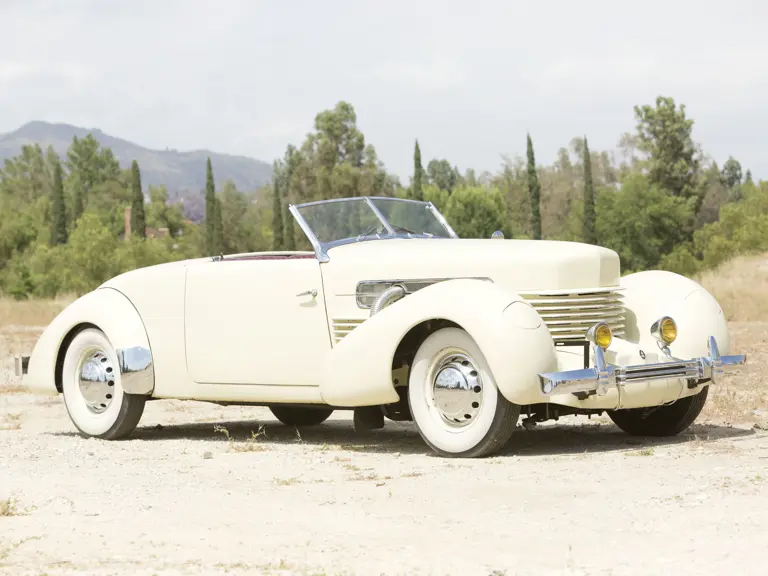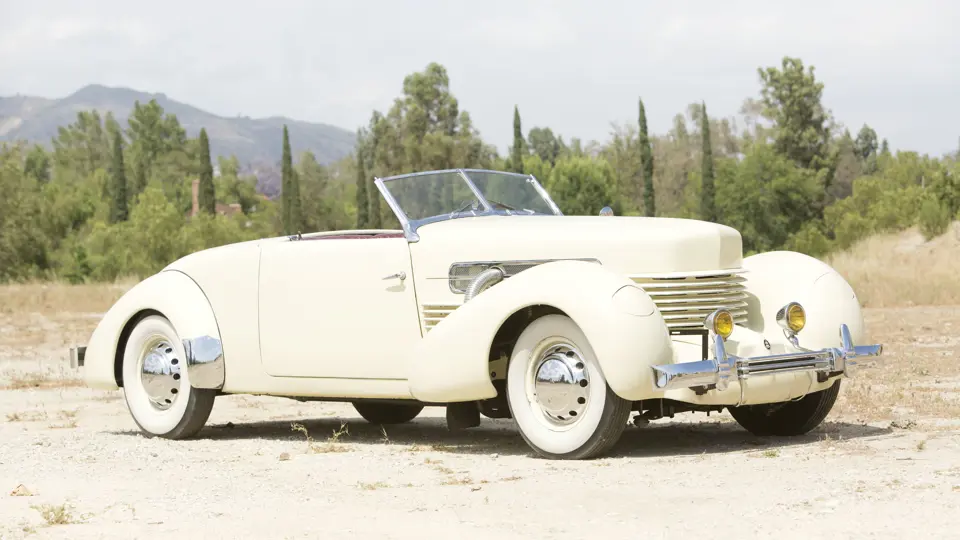Errett Lobban Cord was only one of many earnest, skilled and dedicated entrepreneurs whose dream of establishing an automotive empire to rival Ford, GM and Chrysler was dashed. At one time E.L. Cord controlled the Checker and Yellow cab companies, Duesenberg, Lycoming, Stinson Aircraft and American Airways, among a portfolio of 156 companies. A master salesman who worked his way up through the automobile business, the basis of Cord’s industrial empire was Auburn Manufacturing, which he acquired in 1924. He set to work to resuscitate Auburn and succeeded by creating a performance image that helped sell mundane, but profitable, sedans.
In 1929, Cord took Auburn to the next step, introducing the front-wheel drive Auburn-derived automobile Cord named after himself, the Cord Front Drive – now commonly known as the L29 – with distinctive and sporting appearance and great performance for its price. Shortly thereafter the stock market crashed and with it the market for another Cord project, the Baby Duesenberg. Its distinctive styling – penned by the legendary Gordon Buehrig – provided the basis for a new medium-priced front-wheel drive car from Cord, the 810.
The 810/812 was intended to restore Cord’s auto manufacturing operations to health, using the proven formula: styling, performance and reasonable price.
In the process, Gordon Buehrig’s clean and unadorned coffin-nosed, retractable headlight design would create a standard of automotive beauty by which cars are still judged today.
The 1937 Cords, designated 812, were little changed from 1936 models except for the supercharged engine option. Cord’s experience with Duesenberg, another of the Cord companies and his ownership of Lycoming, made it relatively simple for them to add a Schwitzer-Cummins centrifugal supercharger that provided a maximum of 6-psi boost and increased the Lycoming 269-cid V-8’s power to between 185 and 195 horsepower. The chromed outside exhaust pipes gave external identification. The car is built on a 125-inch wheelbase front-wheel drive platform and also has a four-speed electric pre-selector transmission, independent front suspension and four-wheel hydraulic brakes.
In September of 1937, a Cord crew headed by Ab Jenkins set 35 American stock car speed records on the Bonneville Salt Flats, certified by the AAA Contest Board, including 24 hours at an average speed, including stops, of 101.72 miles per hour.
One of the most attractive – and certainly the rarest – variants of the 810/812 was the Convertible Coupe – often referred to by collectors as the “Sportsman.” Approximately 195 of these very attractive convertible coupes were built during the two year life of the Cord 810/812, though only 64, according to factory records, were supercharged.
Although the early history of the example offered here is not known, a prior owner purchased the car from New England collector Ervin (Bud) Lyon in January of 1997.
Finished in Cigarette cream with correct burgundy leather seats and interior and a tan soft-top, this rare supercharged Cord appears to have benefited from a comprehensive professional restoration, although many years ago. Paint and chrome remain in presentable condition, although the steering wheel and hub exhibit cracks, and the leather also shows its age. The overall accuracy of the restoration is very good and the car remains quite correct. The engine bay shows evidence of both use and maintenance. All major components appear correct, including the rare Stromberg AA-25 carburetor, used only on the supercharged cars. A correct in-dash radio is fitted, along with an accessory heater and a pair of correct Cord accessory driving lights and wide whitewall tires.
Welcomed at Auburn-Cord-Duesenberg Club events and designated as Full Classics by the CCCA, the 810/812 Cords are remarkably advanced cars to drive, fully capable of modern highway speeds at relaxed engine speeds. The example offered here provides the benefit of added horsepower due to supercharging, combined with the delightful open air motoring of a classic era convertible. When the book “Rolling Sculpture, A Designer and His Work” was released, recounting the unparalleled career of Gordon Buehrig, this era of Cord was featured on the cover and is widely recognized as the quintessential definition of this honored term.



 | Auburn, Indiana
| Auburn, Indiana


